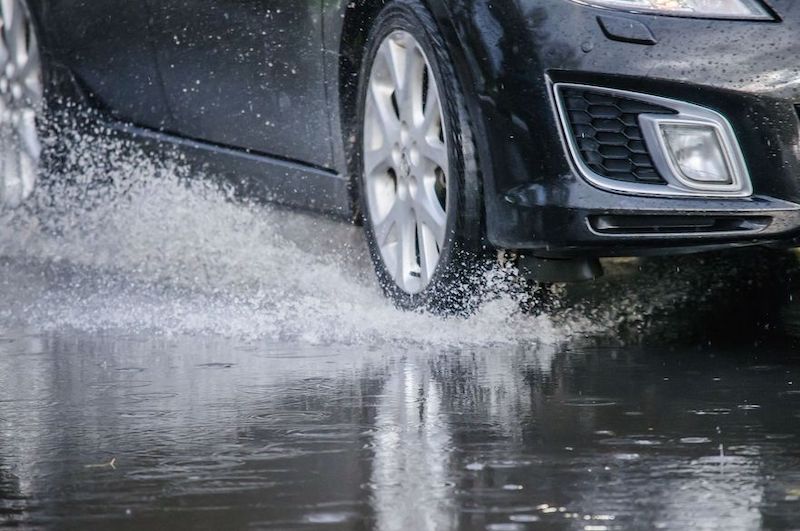Real Driving Road Test. Aquaplaning
Aquaplaning is a complete or partial loss of traction with the road surface, caused by a contact of the vehicle wheels with a water layer (puddle) at a critical speed. The effect occurs due to a so-called hydrodynamic wedge, which appears in the area of tire contact with a road surface when a tire tread fails to remove water from this area. The arising water pressure lifts the tire leading edge, breaking the contact with the road surface and leading to losing control over the wheels.
In fact, several factors influence vehicle steerability on a wet road, causing aquaplaning:
- high critical speed when driving through a pool of water;
- tread depth (worn tires tend to be affected by aquaplaning to a greater extent);
- road surface irregularities (including pavement texture, grades, etc.);
- water layer depth;
- tire inflation pressure;
- car weight and general condition of your vehicle’s suspension system.
Tips from Advanced Drivers about Preventing Aquaplaning
In order to learn how to cope with aquaplaning, you may enroll in an advanced driving course. Such courses are offered by multiple providers and available in various states, helping American drivers to develop practical skills of safe driving (you can learn more about the possibilities in What To Look for in an Advanced Driver-Training Class). But you don’t need to complete the courses and pass an advanced driving test in order to prevent dangerous situations! You just need to follow tips from driving instructors and experienced drivers, who have already passed their advanced driving exams and who strongly believe that it’s smarter to take precautions against aquaplaning than to challenge it. So, let’s see what steps you should take to avoid aquaplaning.
- Stick to safe speed limits
For an inexperienced driving road test? Well, then keep in mind that heavy rain can cause hydroplaning at the speed of 50-55 miles per hour even if your vehicle has new full-tread tires. Worn tires may aquaplane at the speed 20 miles per hour. As a rule, modern new tires ensure reliable control over a car in the rain within the average speed of 40 miles per hour. For a driver, it’s rather hard to determine a safe speed on a wet road as it depends on multiple factors like roadway quality, water layer depth, tire tread depth, and pressure, vehicle type, etc. Didn’t you find any practical advice on safe speed limits in your manual when you was preparing for your

- Watch your tire wear
In America, tire tread depth is measured in 32nds of an inch and new tires usually feature 10 or 11 of 32nds with deeper treads for winter tires. The U.S. Department of Transportation recommends (but doesn’t demand) changing tires with But it should be understood that this depth is a critical safety limit in general, while for effective removal of water during summer rain a minimum tread depth of 4 mm is required.tread depth of 2/32 of an inch, which corresponds to 1.6 mm, and many states legally require replacing tires when they reach this depth, too.
- Choose the right tires
Make sure that your tire design can effectively dissipate water: the desired effect can be achieved through an asymmetrical design with a few wide longitudinal drain passages.
- Monitor tire pressure
Incorrect tire pressure changes traction features in the tire contact area: a flat tire loses traction in the central part of the tread, but when pressure is too high, the traction is lost in tire shoulders.
- Avoid sudden and quick maneuvers when driving
Advanced drivers confirm that any sudden maneuvers, such as steering, braking, or acceleration on a wet road against the background of poor road-gripping properties can cause a skid, understeer, or other problems associated with the loss of control. All maneuvers on a wet road must be done smoothly and in a good time.
- Drive through puddles in a straight line
Tires dissipate water in a transverse direction, so try and drive through water obstacles only in a straight line. In addition to reducing the risk of aquaplaning, "straight" wheels will also allow avoiding skidding in case your car aquaplanes despite all your efforts. longitudinal direction much better than in
What Should You Do If Your Car Aquaplanes?
When practicing various maneuvers before your DMV road test, try and brush up on your tactics under would-be aquaplaning.
- Do not steer! Resist the temptation to act like during skidding on an icy road and hold the steering wheel in the position as it was before hydroplaning started.
- Hold the wheel tightly and in the correct position, since you may lose control over it due to hydrodynamic impact.
- Slow down with your engine, not brakes. Throttle back the engine to reduce your speed until aquaplaning stops.
- When you feel you regained control over your vehicle, use the steering wheel or brakes depending on the situation, but in any case, perform all the maneuvers smoothly.
Yes, aquaplaning is a hard driver’s road test, but if you don’t panic and use our tips, you will pass it without losses. To learn more about driving in treacherous driving conditions, see our Practice Driver Knowledge Test and Learn 10 Tips about Driving on an Icy Road article.








 12 Tips to Gain Extra Miles with Your Electric Vehicle
12 Tips to Gain Extra Miles with Your Electric Vehicle